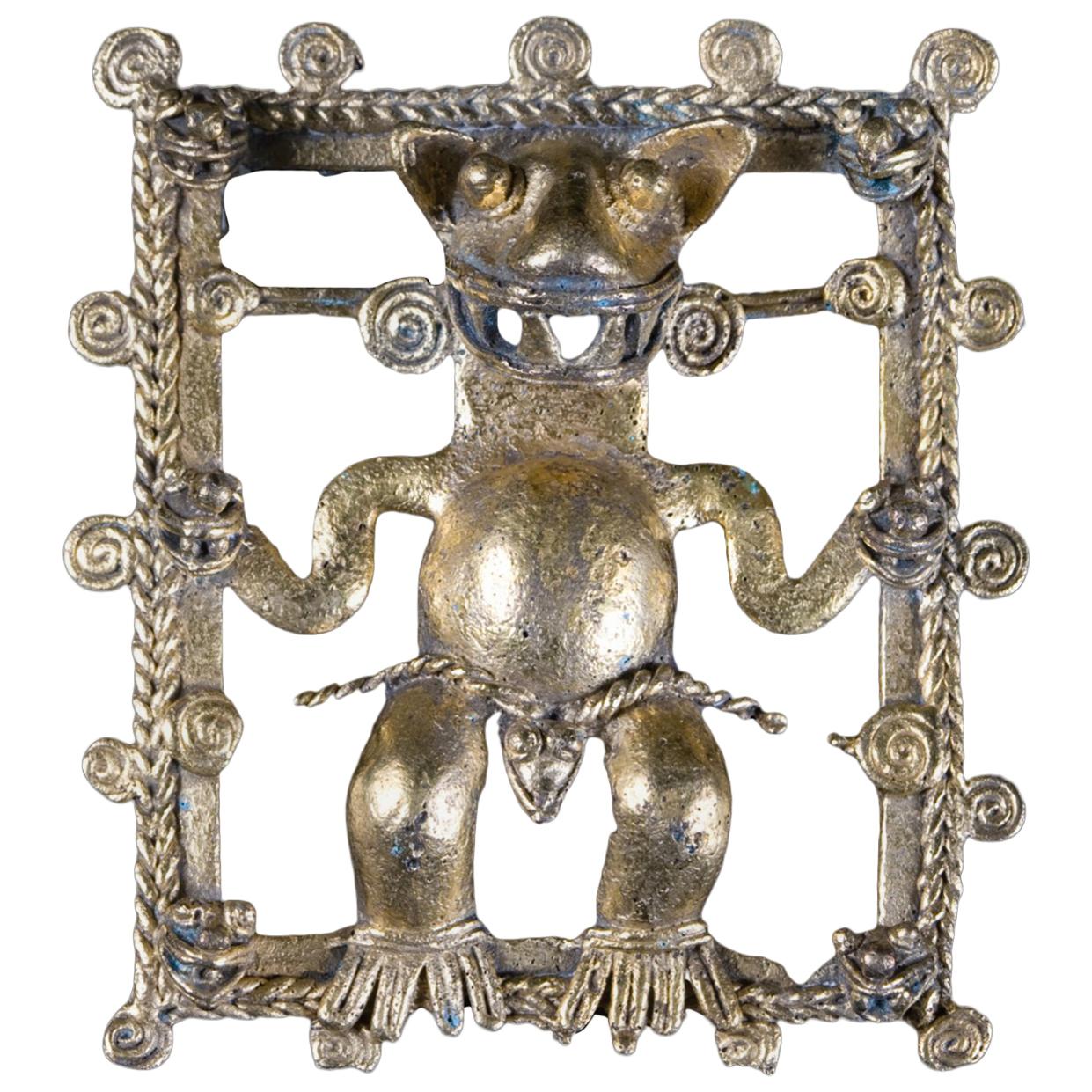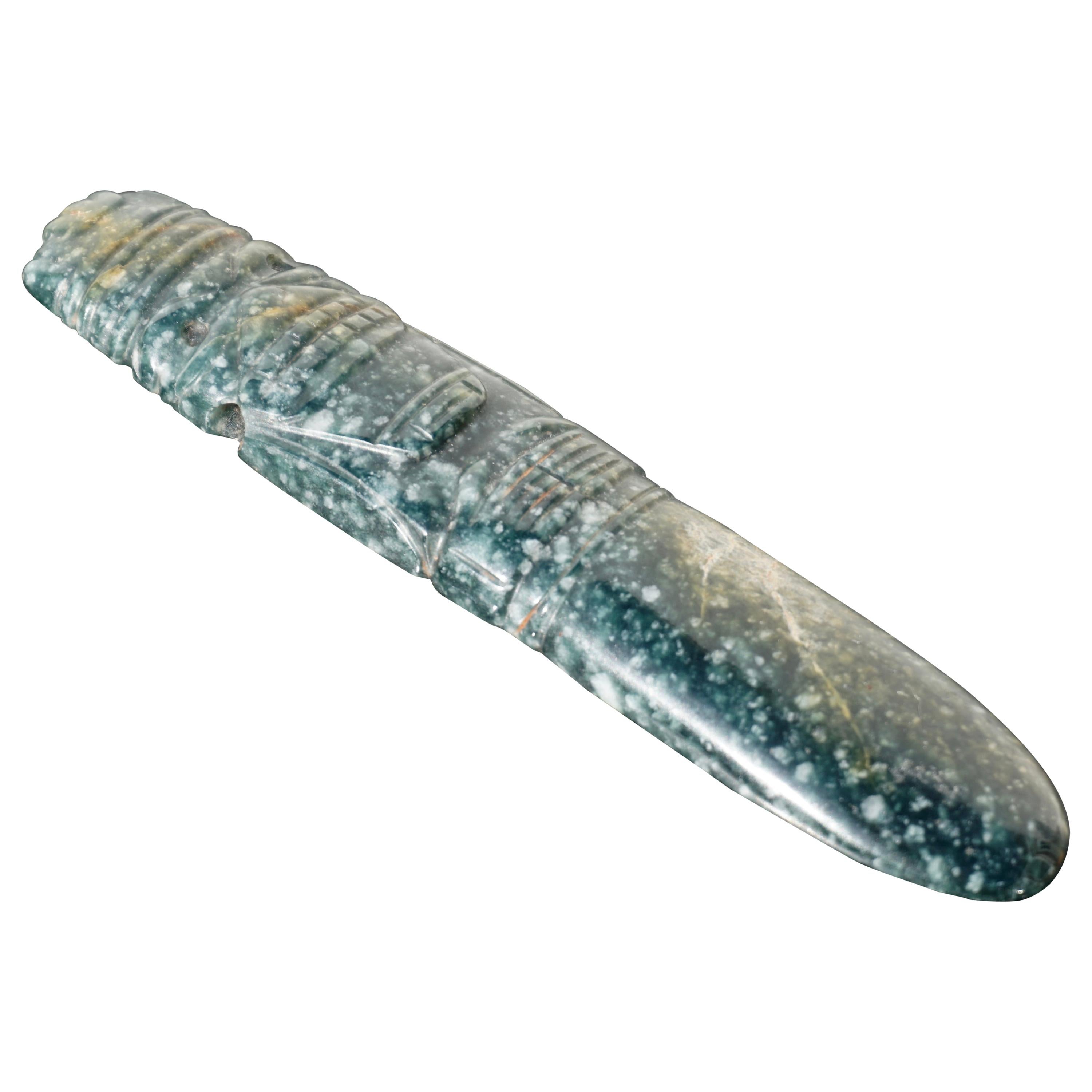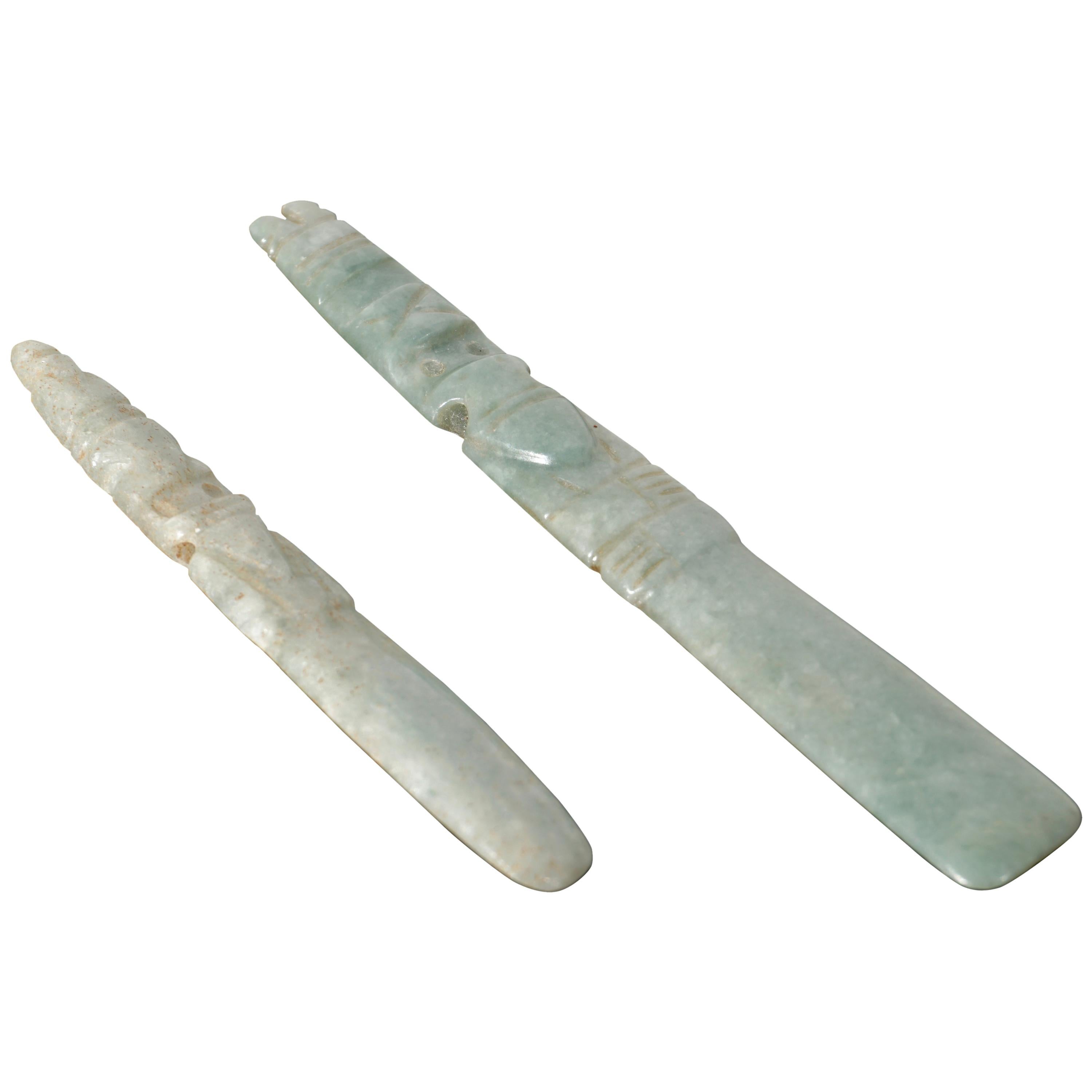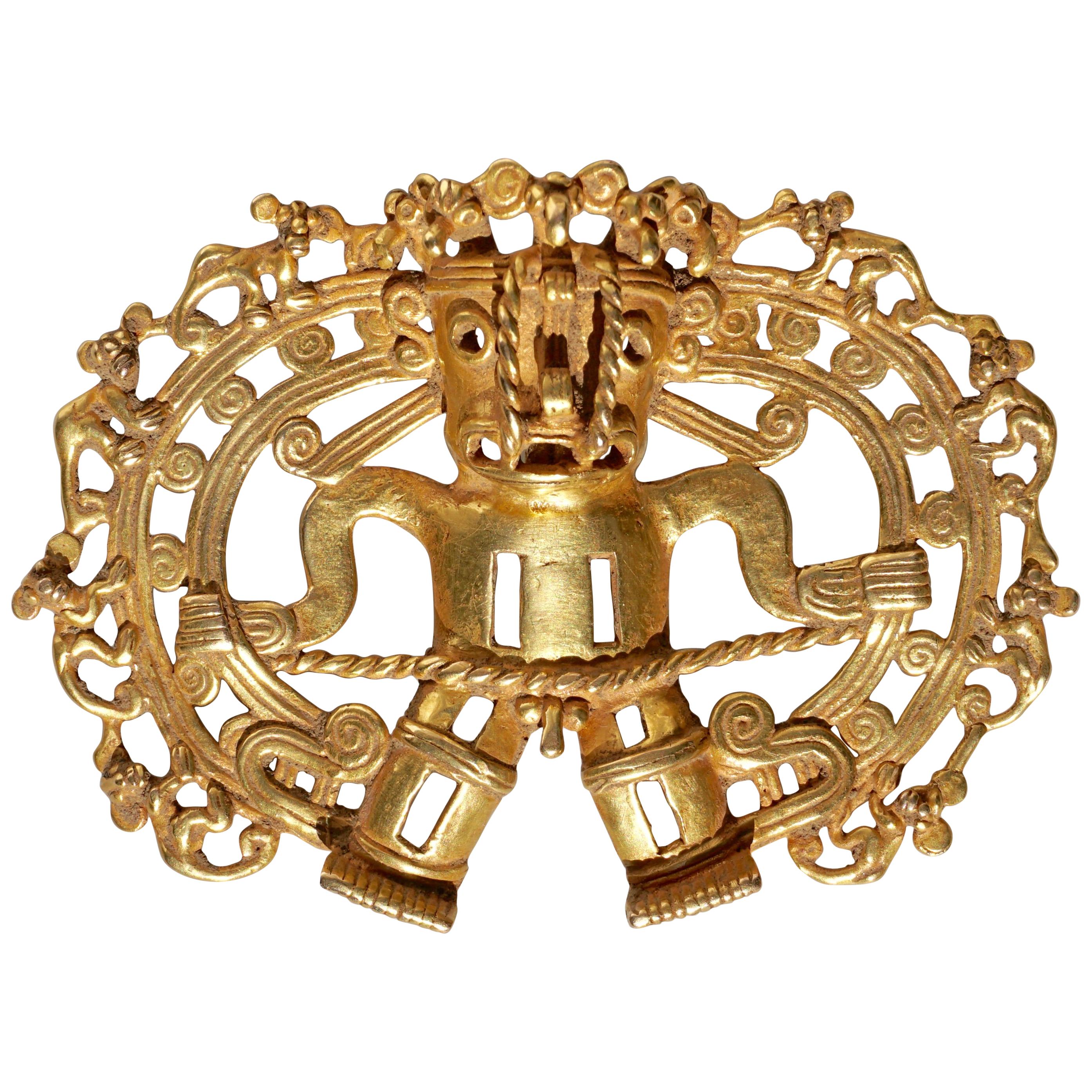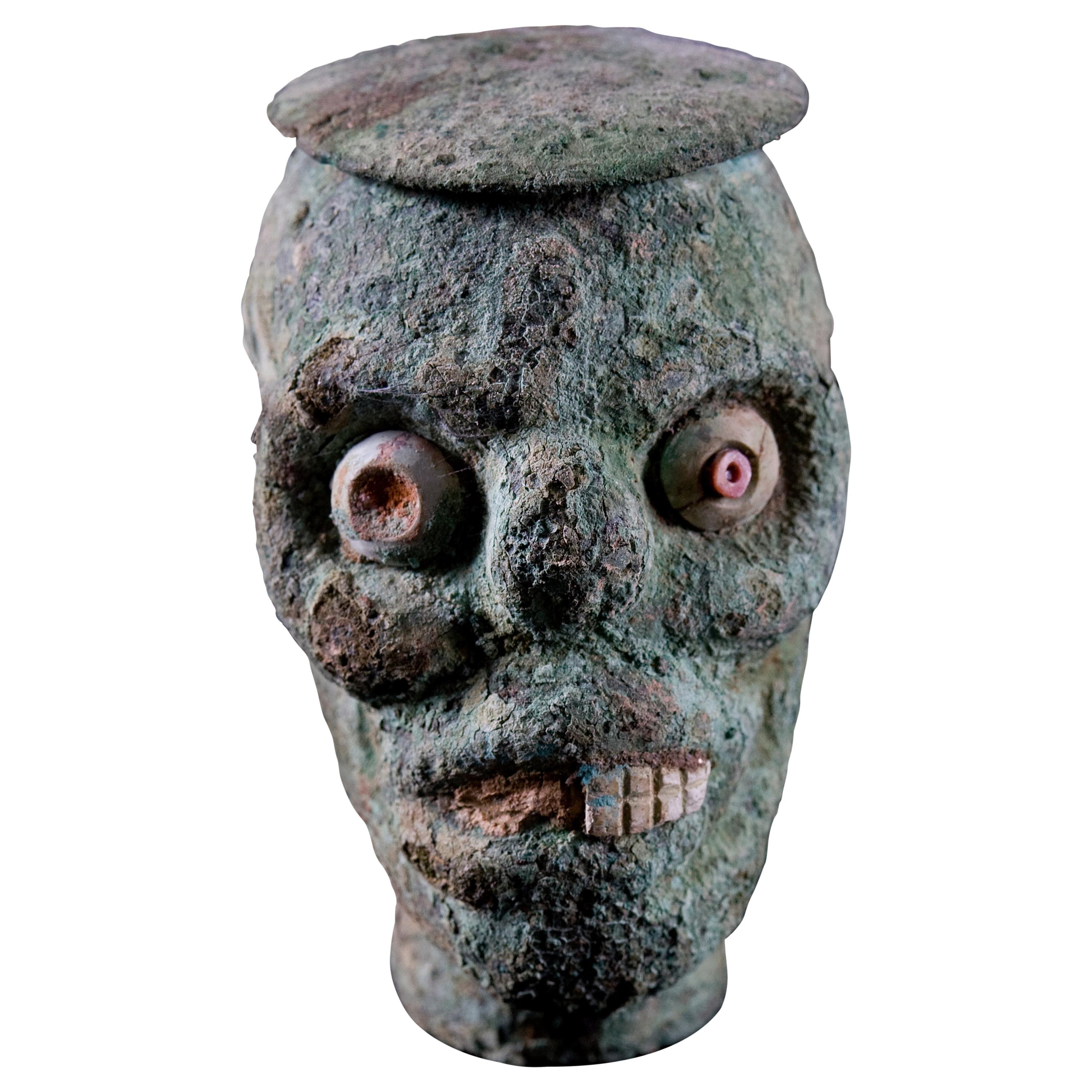Items Similar to Museum Quality Pre-Columbian Gold Twin Figures Pendant, circa 800 to 1500 AD
Want more images or videos?
Request additional images or videos from the seller
Museum Quality Pre-Columbian Gold Twin Figures Pendant, circa 800 to 1500 AD
About the Item
Southern Costa Rica/Western Panama, circa 800 to 1500 AD. Gold Veraguas-Chiriqui-Diquis twin figure pendant cast by the lost-wax (cire perdu) grasping an imaginary club with their claws, with bat ears and pop out eyes and each figure ending in the shape of a jaguar tooth, symbolizing the power of the jaguar and the ability to see in the dark; The casting process did not go entirely smoothly. Part of his mold, on the side of the proper right figure (viewer's left side), did not fill with metal. The Pre-Columbian goldsmith carried out a superb repair, probably making a wax patch and pouring gate on the gold pendant, then enclosing it in a new mold and pouring in more metal. The patch is hardly visible on the outside. A modern goldsmith, who cannot do it as well, would use his gas torch to solder on a patch. The gold is of such high grade or karat, possibly unalloyed native gold, that it shows no sign of corrosion, such as we see in tumbaga, an alloy of gold and copper that Mesoamericans frequently used because of its good casting qualities. This piece comes with an authenticity letter from Mr. Rober Sonin, Feb. 1 2006. reference photo roll 3291.
In Pre-Colombian America (America before Christopher Columbus), gold was developed in the context of ritual and regalia, it was transformed into objects for gods and rulers. The earliest evidence for the working of gold in the New World comes from Peru, in South America. The first salient works were personal ornaments such as headdresses, pectorals, necklaces, ear and nose ornaments and the like. These artifacts were found in royal burials of powerful emperors. These works were often transported across great distances and handed down over generations, making them a primary means by which ideas were exchanged between regions and across time. Crucial bearers of meaning, gold was especially susceptible to destruction and transformation; thus these works are rare testaments to the brilliance of ancient American artists. Gold too was closely associated with the supernatural realm. This majestic material was meant to provoke a strong response - perceptually, sensually, and conceptually - to transport the wearer and beholder into new realms. The imagery of these early works speaks to a rich mythological world of snarling, fantastic beasts and other extraordinary beings.
- Dimensions:Height: 3.25 in (8.26 cm)Width: 5.125 in (13.02 cm)Depth: 1 in (2.54 cm)
- Style:Pre-Columbian (Of the Period)
- Materials and Techniques:
- Place of Origin:
- Period:
- Date of Manufacture:800-1500 AD
- Condition:Wear consistent with age and use. Minor structural damages.
- Seller Location:San Pedro Garza Garcia, MX
- Reference Number:
About the Seller
3.7
Vetted Seller
These experienced sellers undergo a comprehensive evaluation by our team of in-house experts.
1stDibs seller since 2017
22 sales on 1stDibs
- ShippingRetrieving quote...Ships From: Dallas, TX
- Return PolicyA return for this item may be initiated within 3 days of delivery.
More From This SellerView All
- Supernatural Being, Pre-Columbian Gold Pendant, Costa Rica, circa 800 to 1500 ADLocated in San Pedro Garza Garcia, Nuevo LeonSouthern Costa Rica or Western Panama, circa 800 to 1500 AD. A very fine example of the goldwork of the Veraguas-Chiriqui-Diquis region. A pendant in Carbonera style of a supernatural being, a composite monster with human torso and feline (probably jaguar) head. The figure is set in a frame decorated with little animal heads, one at each corner. The hands have also turned into animal heads. In place of genitalia is a stylized serpent head suspended by a twisted cord that was supposed to continue across the frame. A minor casting accident prevented it form being attached to the frame. A modern goldsmith would solder in two short lengths of twisted wire, but the ancient goldsmith did not have the equipment to make such repair. A double thread ending in spirals goes across the frame behind the neck of the figure, helping to fill up the frame and avoiding a large empty space. The word "thread" reminds us that the twisted and straight cords were, in the original wax model of the pendant really extruded wax threads, turned into metal by the lost wax (cire perdue) process. The braid pattern on the frame is illusory, just two twisted threads of extruded wax laid side by side. The goldsmith made the toes out of extruded wax thread too, very decorative as well. The piece comes with a certificate of authenticity by Mr. Robert Sonin, 5 May 2006. ref. photo roll 3301. A world renowned expert on Pre-Columbian Artifacts...Category
Antique 15th Century and Earlier Costa Rican Pre-Columbian Figurative Sc...
MaterialsGold
- Rare Pre-Columbian Moche Copper Skull Vessel, Peru, circa 200-500 ADLocated in San Pedro Garza Garcia, Nuevo LeonA hollow molded copper skull head, lidded vessel having well defined relief features with inset shell eyes and teeth. Lid has a double headed applicator. ...Category
Antique 15th Century and Earlier Peruvian Pre-Columbian Figurative Sculp...
MaterialsCopper
- Pre-Columbian Ica Fringed Textile Panel, Ex Kate Kemper, Peru 800 to 1200 ADLocated in San Pedro Garza Garcia, Nuevo LeonA semi-ovoid rectangular panel with heavily fringed border having a very tightly woven multi-color geometric pattern consisting of two scroll devices containing multiple stylized zoo...Category
Antique 15th Century and Earlier Peruvian Pre-Columbian Antiquities
MaterialsTextile
- Published Pre-Columbian Nicoya Ceremonial Stone Seat, Ex Arizona MuseumLocated in San Pedro Garza Garcia, Nuevo LeonNicoya Ceremonial Basalt Stone Seat in Shape of a Jaguar. Published in the Arizona Museum. This large and finely carved example of Costa Rican skill and craftsmanship is in the form of a jaguar which may have been a lineage or clan symbol - as also was the crocodile - according to 16th-century Spanish conquistadors. There are so many features that make this masterpiece so unique. The most realistic depiction is the face with its head captured in a pose that is threatening and fierce. Sculptors in ancient Central America developed elaborate metate forms that were associated with high status and wealth. They were commonly placed within graves of prominent individuals. Certain ancient rituals must have incorporated this activity and required special metates to be created for this purpose. It may have also served as a throne for the ruler, for whom the assurance of the fertility of his land and people would have been paramount. Even today, stone metates...Category
Antique 15th Century and Earlier Pre-Columbian Animal Sculptures
MaterialsStone
- Pre-Columbian Inca Mantle with 16 Figures, Peru, 1476-1534 ADLocated in San Pedro Garza Garcia, Nuevo LeonInca Mantle with 16 figures in cubist form with multi-color fringes. This pieces with a Certificat de Bien Culturel from France. For the Incas finely worked and highly decorativ...Category
Antique 15th Century and Earlier Peruvian Pre-Columbian Antiquities
MaterialsTextile
- Pre-Columbian Inca Complete Uncu Textile, Peru 1300-1500 AD, Ex Guillot-MuñozLocated in San Pedro Garza Garcia, Nuevo LeonInca Complete Uncu of beautiful geometric composition with serpent form in red, purple and yellow. This beautiful poncho of a geometric composition has only some worn out sections on...Category
Antique 15th Century and Earlier Peruvian Pre-Columbian Tapestries
MaterialsTextile
You May Also Like
- COSTA Rica Jade Avian Axe God Celt Pendant Pre Columbian, 500 Ad-1500 AdLocated in Dallas, TXFine Costa Rican Jade Axe God, Guanacaste-Nicoya region, circa. A.D. 1-1500. Of a celt form depicting the mythical part human- part avian bird figure, with cir...Category
Antique 15th Century and Earlier Costa Rican Pre-Columbian Figurative Sc...
MaterialsJade
- Costa Rica Jade Avian Axe God Celt Pendant Pre Columbian, 500 AD-1500 ADLocated in Dallas, TXFine Costa Rican Jade Axe God, Guanacaste-Nicoya region, ca. A.D. 1-1500 Of celt form depicting the mythical part human- part avian figure, with circular eyes...Category
Antique 15th Century and Earlier Costa Rican Pre-Columbian Animal Sculpt...
MaterialsJade
- Costa Rica Jade Avian Axe God Celt Pendant Pre Columbian, 500 AD-1500 ADLocated in Dallas, TXA fine Costa Rican Jade Axe God. Guanacaste-Nicoya region, circa A.D. 1-1500 Of celt form depicting the mythical part human- part avian figure, with circular...Category
Antique 15th Century and Earlier Costa Rican Pre-Columbian Figurative Sc...
MaterialsJade
- Pre Columbian Gold Shaman with Monkeys Pendant Diquís A.D. 1000-1500Located in Dallas, TXPre Columbian Costa Rican Gold Shaman pendant for necklace Diquís Delta Area; Costa Rica, Panama A.D. 1000-1500 18 Carat; 76.15% gold Gold weight 66 grams...Category
Antique 15th Century and Earlier Costa Rican Pre-Columbian Figurative Sc...
MaterialsGold
- Pre-Columbian Inca Hand Carved Kero / Drinking Vessel, 1300-1500 ADLocated in Ottawa, OntarioThe hand carved beaker-shaped wood drinking vessel was used to drink 'chicha' which was a beer-like beverage made from fermented corn. The weathered exterior showing incised geometri...Category
Antique 15th Century and Earlier Peruvian Pre-Columbian Jars
MaterialsHardwood
- Pre-Columbian Ceramic Head FragmentLocated in Chicago, ILThis intriguing head fragment was once attached to a pre-Columbian bust or full effigy figurine. Earthenware figurines like this were made in great abundance throughout Mesoamerican history, serving a wide variety of purposes and functions from religious rituals to burial offerings. Figurines like this commemorated important people and events across Mesoamerica, portraying individuals of different rank and status such as soldiers, merchants, bureaucrats, and occasionally divinities. This figure is adorned with an elaborate headdress, or coiffure, and ear spools...Category
Antique 15th Century and Earlier Central American Pre-Columbian Figurati...
MaterialsCeramic
